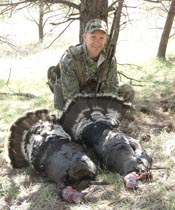It was the turkey equivalent of an Adam Sandler movie; no thought required.
Scott Bestul and I had hiked up a ridge, found a narrow strip of woods, sat down and uttered a few yelps into the Minnesota hills. Lo and behold, a gobbler responded and started charging right in.
Bless that turkey. He was kind enough to dumb everything down and give me a hunt without those pesky in-field decisions.
Of course, that’s the exception rather than the rule. Most hunts involve a critical decision that places a gobbler down your gun barrel or keeps him safe for another day.
One mid-May morning in Wisconsin, I fired up a distant gobbler and moved to the tip of a wooded point to work him. Within seconds, I glimpsed him trotting over the rise, apparently coming to my calling. It was perfect.
Or so it seemed. Instead of waltzing in and graciously accepting a load of No. 6s to the head, the bird descended into the deepest hollow in central Wisconsin and then stood 100 yards away — straight downhill — and gobbled for a half-hour.
What the heck? The longbeard had charged toward my yelping, sat still for 30 minutes and then high-tailed it out of town. I didn’t get it.
The decision was plain enough. I could follow the go-away turkey or stay at my setup for a while, hoping the bird might return to investigate the hot hen he’d heard.
What would you have done?
A) Follow the go-away turkey
B) Sit still and hope the gobbler returns
Click here to make your decision on the forum.
Lovett’s Decision: B
I went with option B and stuck around. After 40 minutes of sitting and calling, I’d had enough and was ready to leave. That’s when I saw a turkey in the distance. It was a hen, and she was walking right at me. Within seconds, she had passed a few feet from my tree, clucking the entire way.
Suddenly, out of the corner of my eye, I glimpsed two strutters dogging the hen. I had to twist my body far to the right, but I managed to get on the trailing bird just as he was about to top the ridge. The shot punctuated a great but odd hunt.
 Jeff Budz and I stood atop a South Dakota ridge, watching a Merriam’s gobble his wattles off 500 yards across a wooded canyon.
Jeff Budz and I stood atop a South Dakota ridge, watching a Merriam’s gobble his wattles off 500 yards across a wooded canyon.
“Brian, go kill that turkey,” he said.
So off I went.
The bird was gobbling regularly, so it was no problem reaching the edge of the timber on the opposite face. But as I peeked out through the pines, I couldn’t see the gobbler. And of course, he’d stopped gobbling.
The turkey had been near a small patch of trees about 75 yards away, atop the crest of the hill. He probably hadn’t strayed too far. If I could reach the trees, I thought, I’d be able to locate the bird and perhaps call him in. However, because I wasn’t familiar with the terrain, my odds of bumping the bird seemed better than average.
On the other hand, the gobbler had been pretty hot, so I might be able to call him down to the timber at the valley’s edge.
What would you have done?
A) Head toward the small patch of trees 75 yards away.
B) Try to call the gobbler down to the timber at the valley’s edge.
Click here to make your decision on the forum.
Lovett’s Decision: A
I decided to get aggressive, and started belly-crawling to the trees atop the hill. When I reached them, I slowly lifted my head and looked around. Sure enough, there was the gobbler’s fan, perhaps 70 yards away, just over another small rise. I readied my shotgun and yelped softly on a mouth call.
Almost instantly, the bird slicked his feathers, turned toward me and started walking in. When he got to 35 yards, I clucked, he stopped, and I dropped him.
 This past May, I hunkered in a fence line at fly-down time, waiting for a bird to gobble from a neighboring property.
This past May, I hunkered in a fence line at fly-down time, waiting for a bird to gobble from a neighboring property.
Sure enough, the gobbler sounded off early, perhaps 150 yards from the property line. Trouble was, two other birds sounded off behind me, about 175 yards away, in some open timber across the town road. I’d hunted those turkeys before and was sick of them. No doubt, they’d fly down into a big hayfield to the west, and spend the day strutting for hens and being obstinate.
I tree-yelped a few times to the off-the-property turkey, and his response was luke-warm at best. However, the across-the-road birds seemed to hit the ground and fire up.
What would you have done?
A) Focus on the luke-warm gobbler 150 yards away from the property line.
B) Focus on the hot gobblers with a history of being obstinate.
Click here to make your decision on the forum.
Lovett’s Decision: A
Having been whipped by those birds so often, I decided to stick with the gobbler 150 yards away from the property line. The sure thing clammed up and didn’t show. And within five minutes, I glimpsed movement behind me as the two previously unkillable gobblers sprinted toward me in the field.
Facing the wrong direction and stuck in the open, I could only watch as one gobbler strutted at 75 steps and the other slowly walked into the woods to the south. I managed to slowly twist around to the right, and when the satellite bird popped out at 40-some yards, I shot, sending both gobblers sprinting back across the road.
